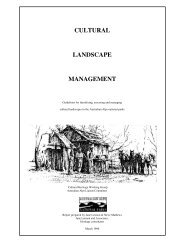The Population Ecology of Wild Horses in the Australian Alps
The Population Ecology of Wild Horses in the Australian Alps
The Population Ecology of Wild Horses in the Australian Alps
Create successful ePaper yourself
Turn your PDF publications into a flip-book with our unique Google optimized e-Paper software.
Contents<br />
Introduction 2<br />
Distribution 3<br />
Abundance 6<br />
<strong>Population</strong> dynamics 8<br />
Brumby-runn<strong>in</strong>g 11<br />
Key management messages 13<br />
References 14<br />
Introduction<br />
From 1999-2002 I studied <strong>the</strong> population ecology <strong>of</strong> wild (feral) horses <strong>in</strong> <strong>the</strong> <strong>Australian</strong><br />
<strong>Alps</strong> for my Doctorate through <strong>the</strong> Applied <strong>Ecology</strong> Research Group, University <strong>of</strong><br />
Canberra (under my maiden name ‘Walter’). <strong>The</strong> <strong>Australian</strong> <strong>Alps</strong> Liaison Committee<br />
(AALC) funded most <strong>of</strong> <strong>the</strong> field work and many parks staff from across <strong>the</strong> <strong>Alps</strong> were<br />
<strong>in</strong>volved. In 2005, <strong>the</strong> AALC commissioned me to summarise my <strong>the</strong>sis <strong>in</strong>to a version<br />
suitable for park managers and this is <strong>the</strong> result. It provides a syn<strong>the</strong>sis <strong>of</strong> <strong>the</strong> work and<br />
its key f<strong>in</strong>d<strong>in</strong>gs. If people are after details <strong>of</strong> any component <strong>of</strong> <strong>the</strong> research, I refer <strong>the</strong>m<br />
to <strong>the</strong> <strong>the</strong>sis and o<strong>the</strong>r references mentioned <strong>in</strong> <strong>the</strong> text. <strong>The</strong>re have been numerous<br />
developments <strong>in</strong> wild horse management s<strong>in</strong>ce 2002, as well as a very large fire. I have<br />
not dealt with <strong>the</strong>m here.<br />
This study was <strong>the</strong> first <strong>of</strong> its k<strong>in</strong>d <strong>in</strong> <strong>the</strong> <strong>Australian</strong> <strong>Alps</strong>, and <strong>the</strong>refore has a broad<br />
focus. It stemmed from a need to improve our understand<strong>in</strong>g <strong>of</strong> this controversial<br />
species and aims to provide <strong>in</strong>terested parties with <strong>in</strong>formation to determ<strong>in</strong>e <strong>the</strong> best<br />
approach to management. It also contributes to broader knowledge on survey<br />
techniques for large mammals and horse population dynamics <strong>in</strong> general and exam<strong>in</strong>es<br />
brumby-runn<strong>in</strong>g for <strong>the</strong> first time. <strong>The</strong> only previous study <strong>of</strong> wild horses <strong>in</strong> <strong>the</strong><br />
<strong>Australian</strong> <strong>Alps</strong> was on <strong>the</strong>ir impact <strong>in</strong> sub-alp<strong>in</strong>e and montane environments (Dyr<strong>in</strong>g<br />
1990).<br />
<strong>Horses</strong> were first <strong>in</strong>troduced <strong>in</strong>to Australia <strong>in</strong> 1788 (Dobbie et al. 1993). <strong>The</strong>y adapted<br />
well to conditions and numbers rose rapidly. Between 1830 and 1850 <strong>the</strong>y <strong>in</strong>creased<br />
from an estimated 14 000 to 160 000 largely by natural <strong>in</strong>crease and were first recognised<br />
as feral pests <strong>in</strong> Australia <strong>in</strong> <strong>the</strong> 1860’s. Australia has <strong>the</strong> highest number <strong>of</strong> wild horses<br />
<strong>in</strong> <strong>the</strong> world (Dobbie et al. 1993). <strong>The</strong>y occur mostly <strong>in</strong> remote, usually rugged, semi-arid<br />
areas. <strong>The</strong> largest populations are on unfenced pastoral country <strong>in</strong> <strong>the</strong> Nor<strong>the</strong>rn<br />
Territory and Queensland. <strong>The</strong> major concentration <strong>of</strong> wild horses <strong>in</strong> New South Wales<br />
and Victoria are found <strong>in</strong> <strong>the</strong> <strong>Australian</strong> <strong>Alps</strong> (Dobbie et al. 1993).<br />
<strong>Wild</strong> horses are an <strong>in</strong>troduced species <strong>in</strong> <strong>the</strong> <strong>Australian</strong> <strong>Alps</strong>. <strong>The</strong>y are a large and hardho<strong>of</strong>ed<br />
animal occupy<strong>in</strong>g an environment that evolved without similar species. <strong>The</strong>re is<br />
concern that <strong>the</strong>y have a negative impact on <strong>the</strong> <strong>Alps</strong> environment. <strong>Wild</strong> horses were<br />
2

















